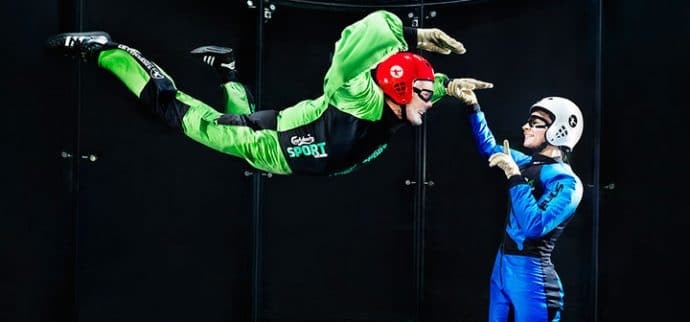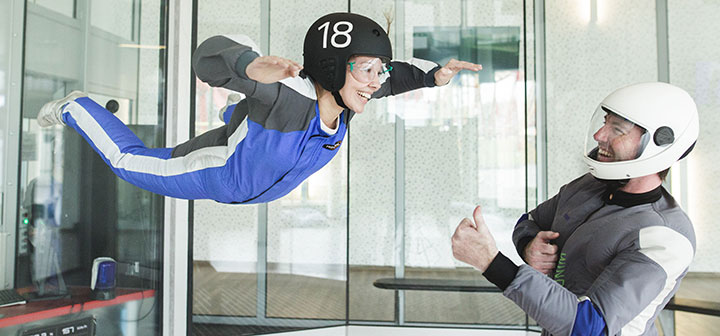Essential Information
What Keeps Indoor Skydiving Safe?

Indoor skydiving has had a fairly short history. Modern tunnel flying has only been around since the mid-80’s. Throughout the formative years, the specialized knowledge of working in a wind tunnel was gathered by the businesses, manufacturers, and individuals working in tunnels. These players ultimately came to formalize and standardize training and safety procedures for tunnels and their staff.
In this article we paint a clear picture of what is really going on at a wind tunnel and the safety considerations that go into every single flight.
Safety & Training Associations
Today a large percentage of wind tunnels belong to one of two main safety organizations. Both of these organizations provide similar services to the tunnels they represent. They maintain a set of training materials and hold instructor training courses for staff at each location. They also provide training and education resources to flyers.
International Bodyflight Association (The IBA)

The IBA was formed in 2003 in Orlando, Florida. It was the first organization of its kind, leading the field in the supporting and training of wind tunnel instructors and setting the standard of safety seen in the industry today. The early days of the organization saw them affiliated with wind tunnel locations built by the SkyVenture manufacturer.
The IBA now supports over 11,000 flyers, coaches, and instructors world-wide with over 60 wind tunnels affiliated to the IBA. Their website offers an array of tools including a flight logbook, tutorial videos and lessons, as well as news and information coverage about tunnels both in and outside their affiliated group. Additionally, the IBA hosts an ongoing event series and have put in considerable work toward growing the indoor skydiving competition world.
Tunnel Instructor

This non-profit organization was founded in 2013. The organization was formed by key players in the European wind tunnel market including Alberto Fuertes, Brendan O’Rafferty, Boris Nebe of Indoor Skydiving Germany, and Paul Mayer of Bodyflight Bedford. The organization works with tunnels across the world to train instructor staff.
The group offers their training materials free of charge and supports the associated flyers and instructors via their website.
The start of the industry was slow until an exponential explosion of popularity which began around 2011. These two organizations have matured quickly and continue to provide excellent training to instructors at new and established locations worldwide. In order to provide a more educated browsing experience here on ISS, we’ve highlighted the governing safety organization of each wind tunnel in our database.
The Role of a Flight Instructor
An experienced, rated flight instructor accompanies every single first-time flyer through the entire flight process. This process includes arriving at the location, a classroom training session, gearing up, flying, and de-gearing after your flight. While you are in the wind you receive one-on-one attention from your instructor the entire time. The instructor assists your entrance, exit and control during your flight. They are there to help you avoid mistakes, teach you the ropes, and assist if anything does go wrong.
Flight Instructor Training Programs
Because of the responsibility of a tunnel instructor, they must undergo a rigorous training regimen. This course prepares them to introduce brand new flyers to the wind, as well as eventually work with experienced flyers.
The training requires an instructor to meet certain physical and strength requirements. They then take part in a training program that normally takes a month of full-time work to complete. During this time the instructor learns to move and walk in the wind, work with new flyers, prevent, and ultimately handle any potentially dangerous situations that may occur. It’s not uncommon for potential instructors to fail the course due to the intensity.
After the initial rigorous training, the teachings are not over. An instructor continues to progress through the advanced levels/classes of instructor ratings. Additional experience provides them with the ability to work in faster wind speeds, learn advanced training and spotting techniques, and be responsible for more experienced flyers. At the highest levels, these same instructors can become rated to then train new instructors. It takes many years for an instructor to reach the highest levels.
Debunking the Association with Skydiving
While indoor skydiving takes its name from the ‘death-defying’ act of jumping from a real airplane, the two activities are actually very different. Using the term skydiving is a double-edged sword for the indoor skydiving industry. It attracts thrill-seeking visitors to our wind tunnels, but can also paint a false picture of what takes place at these facilities.
The thrills that skydiving provides have attracted people around the world to jump at dropzones around the world. Just like any extreme sport, there are accidents when people jump from airplanes. The news and media also love to sensationalize the infrequent accidents that do happen.
Indoor skydiving does not share the same dangers of skydiving.
It’s not to say that there are no risks associated with indoor skydiving – but the potential risks are much different, and much less severe than those with making a skydive.
A much better name for indoor skydiving would be simply body flight. It describes precisely what you’re there to do – fly your body on a smooth column of air. There is no jumping from anything, no parachute, and you’re accompanied by a trained and rated instructor during your entire flight.
Is Indoor Skydiving Safe?

With proper instruction, the correct equipment (which is provided by the facility to all flyers), and cooperation by the flyer, indoor skydiving is very safe. The inherent safety of body flight can be clarified by looking at the requirements for participants. The wide range of people that can participate is an indication of the low-risk nature of the sport.
Most locations allow flyers as young as 3 years old. In addition, there is usually an upper weight limit around 250-270lbs. This provides indoor skydiving as an option for the majority of the worldwide population. The shortlists of general restricted conditions includes previous shoulder dislocations, pregnant women, and those with hard casts. If you’d like some more information on who can fly, see our article on the subject.
The biggest potential risk a flyer can face is simply ignoring your flight instructors guidance. The instructor is there to guide you from start to finish – and encourage you to have a fun and safe flight. Disregarding or fighting against their instruction can result in dangerous situations. Even if you find yourself in a situation like this, the instructor is extensively trained to handle any situation that may occur.
Tips for a Safe, Fun First Flight
- Listen to your instructor.
- Move slowly and predictably.
- Don’t be afraid to ask any questions you have.
- Relax, breathe, and smile!
For further reading, we keep a wealth of indoor skydiving knowledge on our site. We also catalog all indoor skydiving facilities around the world to help you find a location to fly. Share your thoughts in the comments below.
Published: July 18, 2017 | Last Updated: December 2, 2021
Don’t miss an update!
Join our mailing list for the latest indoor skydiving updates delivered directly to your inbox.
"*" indicates required fields

